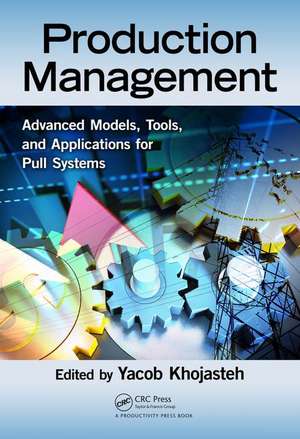Production Management: Advanced Models, Tools, and Applications for Pull Systems
Autor Yacob Khojastehen Limba Engleză Hardback – 31 oct 2017
This book provides some recent developments in production management and presents modeling and analysis tools for pull production control systems. It contributes by combining theoretical findings and case study analysis results with a practical and contemporary view on how to effectively manage and control production systems.
Each chapter in this book focuses on a specific topic in production control systems, allowing readers to identify the chapters that relate to their interests. More specifically, the book is presented in three sections. The first section focuses on the design and implementation aspects of the pull production control systems, as well as performance evaluation approaches for pull systems. The second section presents a recent and comprehensive literature review. Three different case studies on implementation of pull production control systems are presented in the last section.
This book can be used as an essential source for students and scholars who need to specifically study the pull control systems. Since the superiority of these systems is controversial, the book can also provide an interesting and informative read for practitioners, managers, and employees who need to deepen their knowledge on pull production management systems.
Preț: 393.26 lei
Nou
Puncte Express: 590
Preț estimativ în valută:
75.27€ • 81.79$ • 63.27£
75.27€ • 81.79$ • 63.27£
Carte tipărită la comandă
Livrare economică 21 aprilie-05 mai
Preluare comenzi: 021 569.72.76
Specificații
ISBN-13: 9781138032217
ISBN-10: 1138032212
Pagini: 228
Ilustrații: 83 Line drawings, black and white; 5 Halftones, black and white; 54 Tables, black and white; 88 Illustrations, black and white
Dimensiuni: 178 x 254 x 18 mm
Greutate: 0.54 kg
Ediția:1
Editura: Taylor & Francis
Colecția Productivity Press
Locul publicării:Oxford, United Kingdom
ISBN-10: 1138032212
Pagini: 228
Ilustrații: 83 Line drawings, black and white; 5 Halftones, black and white; 54 Tables, black and white; 88 Illustrations, black and white
Dimensiuni: 178 x 254 x 18 mm
Greutate: 0.54 kg
Ediția:1
Editura: Taylor & Francis
Colecția Productivity Press
Locul publicării:Oxford, United Kingdom
Public țintă
Professional and Professional Practice & DevelopmentCuprins
Part I: Design, Implementation, and Performance Evaluation
Chapter 1: Pull Production Control Systems: Selection and Implementation Issues
Yacob Khojasteh
Chapter 2: Kanban Allocation Policies of Multiproduct Production Control Strategies
Oladipupo Olaitan, Paul Young, and john Geraghty
Chapter 3: BK-CONWIP Adaptive Control Strategies in a Multi-Product Manufacturing System
Paolo Renna
Chapter 4: Impact of Reworking in Job-Shop Environments Controlled by Kanban System
Pedro L. González-R, and Marcos Calle
Chapter 5: Takt Time Grouping: A New Approach to Flow Manufacturing
Mitchell A. Millstein and Joseph S. Martinich
Chapter 6: A Framework for Performance Evaluation of Pull Systems
Vinodh S, Ben Ruben, and Asokan P
Part II: Review on Pull Systems
Chapter 7: CONWIP and Hybrid CONWIP Production Control Systems: A Literature Review
Mehmet B. Durmusoglu and Canan Aglan
Part III: Pull Systems Implementation – Case Studies
Chapter 8: Making CONWIP Scheme in One-of-a-kind Production: A Case Study
Guodong Huang and Jie Chen
Chapter 9: Setting Push-Pull Boundaries – A Case of Textile Manufacturer
Md Sarder, Jubaer Ahmed, and Md. Salahuddin Ayuby
Chapter 10: Balancing Flexibility and Lean in Manufacturing Environments
Gwendolyn Holowecky and Ratna Babu Chinnam
Chapter 11: A Lean Approach to Selecting a Proper Measure of Supply Chain Strategy
Mohammad D. AL-Tahat, Ibrahim A. AL-Rawabdeh, and Malek A. AL-Bakri
Chapter 1: Pull Production Control Systems: Selection and Implementation Issues
Yacob Khojasteh
Chapter 2: Kanban Allocation Policies of Multiproduct Production Control Strategies
Oladipupo Olaitan, Paul Young, and john Geraghty
Chapter 3: BK-CONWIP Adaptive Control Strategies in a Multi-Product Manufacturing System
Paolo Renna
Chapter 4: Impact of Reworking in Job-Shop Environments Controlled by Kanban System
Pedro L. González-R, and Marcos Calle
Chapter 5: Takt Time Grouping: A New Approach to Flow Manufacturing
Mitchell A. Millstein and Joseph S. Martinich
Chapter 6: A Framework for Performance Evaluation of Pull Systems
Vinodh S, Ben Ruben, and Asokan P
Part II: Review on Pull Systems
Chapter 7: CONWIP and Hybrid CONWIP Production Control Systems: A Literature Review
Mehmet B. Durmusoglu and Canan Aglan
Part III: Pull Systems Implementation – Case Studies
Chapter 8: Making CONWIP Scheme in One-of-a-kind Production: A Case Study
Guodong Huang and Jie Chen
Chapter 9: Setting Push-Pull Boundaries – A Case of Textile Manufacturer
Md Sarder, Jubaer Ahmed, and Md. Salahuddin Ayuby
Chapter 10: Balancing Flexibility and Lean in Manufacturing Environments
Gwendolyn Holowecky and Ratna Babu Chinnam
Chapter 11: A Lean Approach to Selecting a Proper Measure of Supply Chain Strategy
Mohammad D. AL-Tahat, Ibrahim A. AL-Rawabdeh, and Malek A. AL-Bakri
Descriere
This book can be used as an essential source for students and scholars who need to specifically study the pull control systems. Since the superiority of these systems is controversial, the book can also provide an interesting and informative read for practitioners, managers, and employees who need to deepen their knowledge on pull production management systems.
